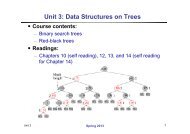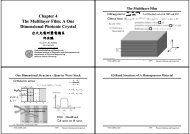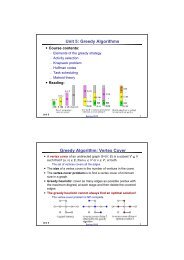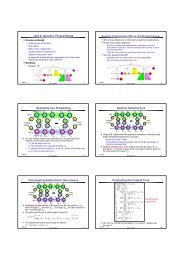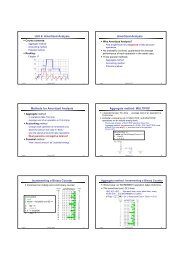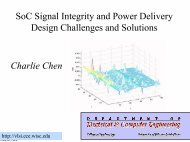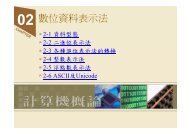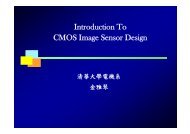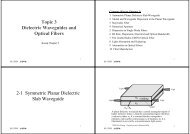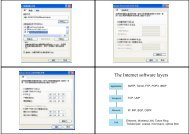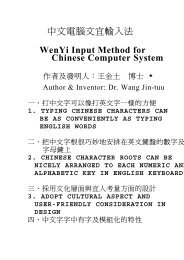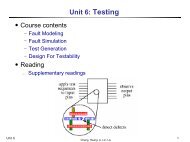S. H. Tseng, "PSTD Simulation of Optical Phase Conjugation of Light ...
S. H. Tseng, "PSTD Simulation of Optical Phase Conjugation of Light ...
S. H. Tseng, "PSTD Simulation of Optical Phase Conjugation of Light ...
Create successful ePaper yourself
Turn your PDF publications into a flip-book with our unique Google optimized e-Paper software.
OPC, the OPC effect causes light to propagate in reversed directions through the scattering<br />
medium and refocus without loss.<br />
6. Discussions<br />
OPC refocused energy (%)<br />
20<br />
15<br />
10<br />
5<br />
0<br />
0 10 20<br />
duration (ps)<br />
30<br />
Fig. 5. The total OPC refocused energy vs. duration <strong>of</strong> the serial OPC simulation. <strong>Light</strong><br />
traveling long optical paths before reaching the OPC inversion region is accommodated by<br />
long duration <strong>of</strong> the serial OPC simulation. Ideally, the total OPC refocused energy is the total<br />
energy <strong>of</strong> light that impinges the PCM.<br />
To accurately model the OPC phenomenon <strong>of</strong> light propagating long optical paths through a<br />
large-scale scattering medium, the previously reported simulation technique [2] falls short as<br />
it requires an enormous amount <strong>of</strong> computations. For example, with an 8-core Xeon<br />
Woodcrest 3.0GHz processor, a typical OPC simulation as shown in this paper accounting for<br />
optical paths <strong>of</strong> as long as 9,600 µm would require a runtime <strong>of</strong> ~1,600 hours. With the<br />
proposed serial simulation technique reported in this paper, the runtime is reduced to ~167<br />
hours. Therefore, the proposed serial simulation technique dramatically reduces the computer<br />
requirements for simulating the OPC phenomenon <strong>of</strong> light propagating long optical paths.<br />
As shown in this paper, the reported serial OPC simulation technique is achieved by<br />
storing and later sequentially stitching the OPC inversion fields together. Based on the<br />
mathematical characteristics <strong>of</strong> Maxwell’s equations, electromagnetic field values are affected<br />
only by local field derivatives and depend little on remote field values; thus, the OPC stitching<br />
<strong>of</strong> electromagnetic field enables reconstructing the macroscopic scattered light field with<br />
some artifacts due to discontinuities <strong>of</strong> the sequential OPC field inversion. The simulation<br />
artifacts only affect local field values and are later corrected by sequentially inserted OPC<br />
inversion field values. After sequentially inserting all OPC inverted fields, the OPC inverted<br />
propagation <strong>of</strong> light is reconstructed without error.<br />
In summary, by sequentially stitching together the electromagnetic fields, the OPC<br />
phenomenon <strong>of</strong> light multiply scattering through optically thick scattering medium can be<br />
simulated with limited computational memory. The proposed simulation technique enables<br />
OPC simulation <strong>of</strong> light propagating long, sinuous optical paths that is not possible otherwise.<br />
Furthermore, the ideal efficiency <strong>of</strong> OPC refocusing <strong>of</strong> light through scattering medium can<br />
be accurately determined.<br />
Acknowledgments<br />
The author thanks Changhuei Yang and Emily McDowell for insightful discussions. The<br />
author thanks the Taiwan National Science Council Grant NSC-96-2112-M-002-028-MY3 for<br />
the support <strong>of</strong> this research.<br />
#105789 - $15.00 USD Received 5 Jan 2009; revised 18 Mar 2009; accepted 18 Mar 2009; published 23 Mar 2009<br />
(C) 2009 OSA 30 March 2009 / Vol. 17, No. 7 / OPTICS EXPRESS 5495



